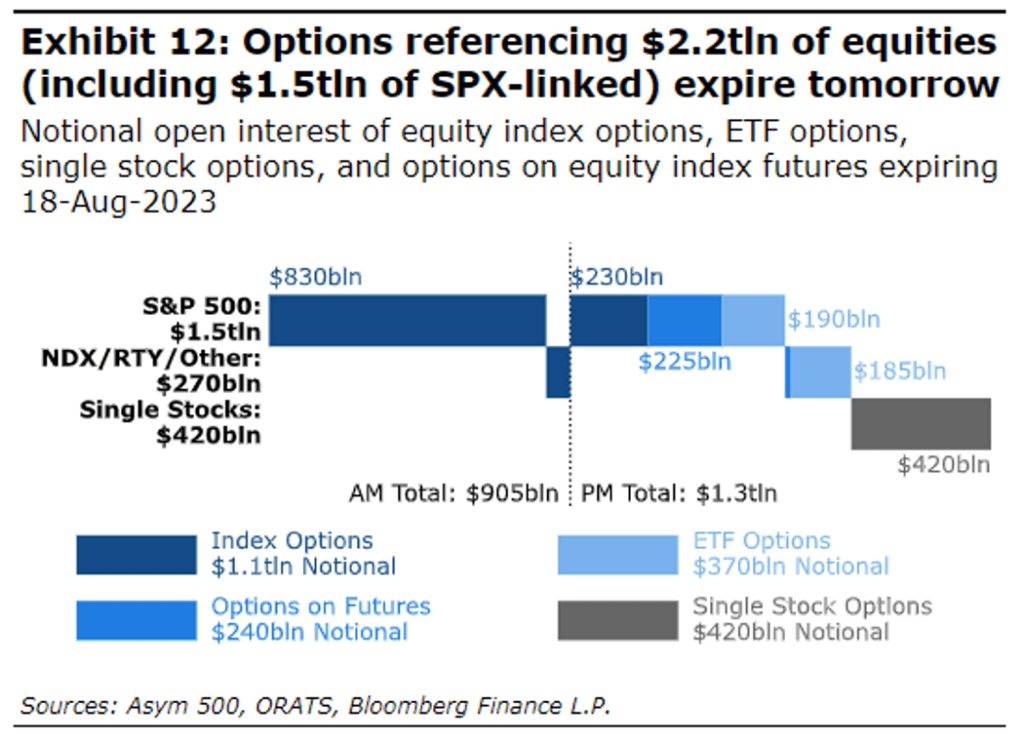Stock Market Showdown: $2.2 Trillion Options Expiry Spells Volatile Friday Trading
Once more, the monthly stock market options for August are nearing their conclusion on Friday, which may lead to heightened instability in the stock market after a challenging three-week period.
Rocky Fishman, the creator of Asym 500, a strategic firm, and former leader of index derivatives strategy at Goldman Sachs Group, states that there are American stock option contracts worth $2.2 trillion that are close to their expiry date. These contracts represent the total value of the stocks, indexes, and exchange-traded funds controlled by the options. It is worth mentioning that the actual amount paid by the option holders as premiums is considerably lesser in value.

According to Fishman, the number of options contracts that will expire on Friday is normal for a month when there are not many expirations.
Options expire every month. However, every three months in March, June, September, and December, a unique event called “Triple Witching” takes place. During Triple Witching, the value of expiring options increases significantly as both quarterly and sometimes yearly options expire, in addition to the monthly and weekly options.
Experts in the options market warned that Friday may see an uptick in volatility, much like previous sessions when monthly options expire.
Charlie McElligott, a derivatives strategist who shares his research with Nomura’s trading desk, has warned his clients about the dangers of option dealers being “short gamma” as the expiration day on Friday nears. This situation has the potential to intensify market volatility, according to McElligott, who presented a chart that illustrated this pattern.
Fishman noted that the level of open interest in the option market set to expire on Friday is normal for a month that is not particularly busy.
Monthly options expire every month, but there is a unique event known as “Triple Witching” that takes place once every quarter, in March, June, September, and December. This event is significant because it leads to a substantial increase in the value of expiring options. During Triple Witching, not only do monthly and weekly options expire, but also quarterly options, and occasionally yearly options as well.
Experts in the options market warned that there could be more significant fluctuations on Friday, comparable to what is usually seen during sessions when monthly options expire.
Charlie McElligott, a Nomura derivatives strategist, warned clients that option dealers face a disadvantage in terms of gamma value, which may lead to increased market volatility. McElligott used a chart to visually illustrate this.

Gamma is employed by options analysts to gauge the pace at which an option’s delta alters. Delta represents the level of sensitivity of an option’s price towards adjustments in the underlying asset. As an option approaches its expiration, delta tends to rise considerably due to the fact that slight movements towards profitability or unprofitability can greatly impact the option’s price.
SpotGamma’s founder, Brent Kochuba, recently discussed the potential risks of dealers having a short-gamma position in research he shared with clients. SpotGamma specializes in providing clients with valuable information and analysis specifically focused on the option market.
The speaker mentioned that they have been noticing a decrease in market gamma, which has consistently remained in negative gamma territory over the course of the whole month. They pointed out that this led to increased unpredictability in the price fluctuation, just as expected in these situations. These remarks were communicated in written form to both MarketWatch and SpotGamma customers.
Option contracts give traders the liberty to buy or sell different assets or currencies, without being obligated to do so. Usually, options tied to stock-market indexes, like the S&P 500, are resolved using futures or cash. On the other hand, options associated with exchange-traded funds, such as the SPDR S&P 500 ETF Trust (SPY), which replicates the S&P 500 index, are settled in the form of ETF shares.

A put option allows the buyer to decide whether or not to sell stocks at a specific prearranged price known as the “strike price,” but it is not obligatory. In contrast, a call option gives the holder the privilege to buy stocks. Typically, when the value of the underlying stock or index decreases, put options tend to rise in value, whereas the opposite is true for call options.
The S&P 500 and Nasdaq Composite faced a potential third consecutive week of decline on Thursday as U.S. stocks ended the day with a decrease. This would mark the S&P 500’s longest period of decline since February.
The S&P 500 witnessed a decline of 0.8% on Thursday, while the Nasdaq Composite fell by 1.2% to a level of 13,316.93. In a similar fashion, the Dow Jones Industrial Average saw a drop of 290.91 points, which is also a decrease of 0.8%, bringing its value to 34,474.83.
In addition to the monthly options that end on Friday, there are also weekly options known as “zero days until expiration” or “0DTE” options, which can complicate the market’s reaction. An experienced strategist from Goldman Sachs Group recently expressed worries, pointing out that 0DTE traders have been holding back stock price increases and adding pressure when the market is falling.




